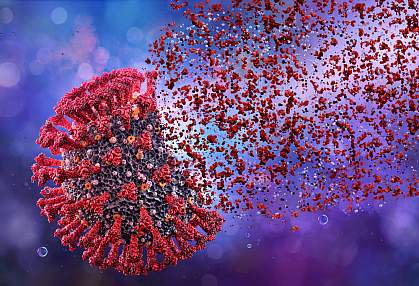SARS-CoV-2片段可能会在感染后引发问题
概要
大多数COVID-19病例病情较轻,但许多病例仍会导致危及生命的并发症。严重病例的特点是免疫反应过度活跃,导致危险的炎症。这种炎症会影响许多不同的组织和细胞类型,包括未感染的组织和细胞,类似于某些自身免疫性疾病。
研究人员发现SARS-CoV-2中存在一种特殊片段,称为xenoAMPs(异源抗菌肽),这些片段可以引发过度的免疫反应。与导致普通感冒的冠状病毒相比,SARS-CoV-2含有更多的xenoAMPs,并且这些异源AMP更接近于真正的AMP(抗菌肽)。当xenoAMPs与双链RNA结合时,它们会形成液晶结构,这种结构和AMPs与双链RNA结合时形成的结构相似。这些结构可以与控制先天性免疫反应的受体结合。在各种类型的人体细胞中进行测试时,异种AMP-双链RNA复合物增强了炎症反应。它们还引发了与 SARS-CoV-2 感染相似的基因活性变化。而来自普通感冒冠状病毒的肽则没有与双链RNA结合并形成这样的结构。它们也没有增强细胞的炎症反应。
此外,研究人员将其中一种异种AMP-双链RNA复合物注射到小鼠血液中。注射后,小鼠血液中的促炎分子水平升高,与COVID-19患者的情况类似。它们的各种免疫细胞水平也更高。
这些发现可能为治疗严重的COVID-19患者带来新策略。它们还提出了一种方法来确定未来的冠状病毒是否会引起类似的炎症。从更广泛的意义上讲,这些研究结果表明了病毒是如何在被免疫系统消灭后继续影响宿主的。
SARS-CoV-2 fragments may cause problems after infection
At a Glance
- Researchers found that fragments of SARS-CoV-2 left behind after the immune system fights off infection may continue to trigger immune responses.
- The findings help explain some unusual aspects of COVID-19 and suggest a previously unappreciated way that viruses can make people sick.

The destruction of SARS-CoV-2 doesn’t always mark the end of COVID-19. Corona Borealis Studio / Shutterstock
Most COVID-19 cases are mild, but many still lead to life-threatening complications. Severe cases feature an overactive immune response that causes dangerous inflammation. This inflammation affects many different tissues and cell types, including uninfected ones, and resembles that seen in some autoimmune diseases. It’s not clear why SARS-CoV-2 can cause such inflammation while other coronaviruses responsible for common colds don’t.
One way the immune system fights viruses is by breaking down the viral proteins into small fragments called peptides. An NIH-funded research team—led by Dr. Gerard Wong at the University of California, Los Angeles, in collaboration with Richard L. Gallo at the University of California, San Diego—investigated whether these peptides could continue to activate the immune system. Their results were published in Proceedings of the National Academy of Sciences on February 6, 2024.
The team used machine learning to search SARS-CoV-2 proteins for fragments that resemble molecules called antimicrobial peptides (AMPs). The body makes these molecules as part of its defense against infections. Certain AMPs can bind to double-stranded RNA (dsRNA), which is produced during some viral infections. The resulting AMP-dsRNA complexes have been shown to trigger inflammation and have been implicated in autoimmune conditions such as lupus, rheumatoid arthritis, and psoriasis. Among the SARS-CoV-2 AMP-like fragments, the team looked for those that carried a strong positive electric charge. This would allow them to bind dsRNA, which is negatively charged.
The researchers studied three SARS-CoV-2 fragments that both resembled AMPs and had a large positive charge. These fragments were also found in the airways of patients with severe COVID-19. The scientists dubbed these AMP-like peptides “xenoAMPs.” Notably, SARS-CoV-2 contained more potential xenoAMPs than common cold coronaviruses. SARS-CoV-2 xenoAMPs also mimicked real AMPs more closely than those from common cold coronaviruses.
XenoAMPs bound to dsRNA and caused it to form liquid crystalline structures like those formed when AMPs bind to dsRNA. These structures were the optimal size and shape for binding to certain receptors that control the innate immune response. When tested in various types of human cells, the xenoAMP-dsRNA complexes enhanced inflammatory responses. They also triggered gene activity changes resembling those triggered by SARS-CoV-2 infection. Corresponding peptides from a common cold coronavirus did not bind and form such structures with dsRNA. They also did not enhance inflammation in the cells.
The researchers injected one of the xenoAMP-dsRNA complexes into the bloodstream of mice. After they did, the mice had higher levels of proinflammatory molecules in the blood, similar to those seen in people with COVID-19. They also had higher levels of various immune cells.
These findings could lead to new strategies for treating severe cases of COVID-19. They also suggest a way to determine whether future coronaviruses could cause similar inflammation. More generally, they show how viruses can continue to affect the host even after they’re destroyed by the immune system.
“The textbooks tell us that after the virus is destroyed, the sick host ‘wins,’ and different pieces of virus can be used to train the immune system for future recognition. COVID-19 reminds us that it’s not this simple,” Wong explains. “For comparison, if one were to assume that after food gets digested into its molecular components, then its effects on the body are over, it would be very liberating. I wouldn’t have to worry about the half-dozen jelly donuts I just ate. However, this simple picture is not correct.”
—by Brian Doctrow, Ph.D.
Source:
National Institutes of Health
Published on 27 February, 2024
声明:本站文章版权归原作者及原出处所有。本文章系本站编辑转载,文章内容为原作者个人观点,登载该文章的目的是为了学习交流和研究,并不代表本站赞同其观点和对其真实性负责,本站只提供参考并不构成任何投资及应用建议。
本站是一个学习交流和研究的平台,网站上部分文章为引用或转载,并不用于任何商业目的。我们已经尽可能的对作者和来源进行了告知,但是能力有限或疏忽,造成漏登或其他问题,请及时联系我们,我们将根据著作权人的要求,立即更正或删除有关内容。本站拥有对本声明的最终解释权。








